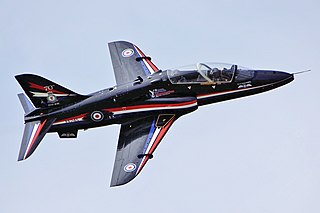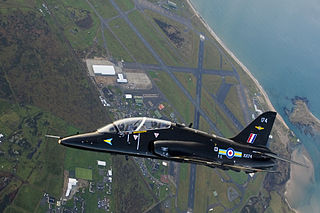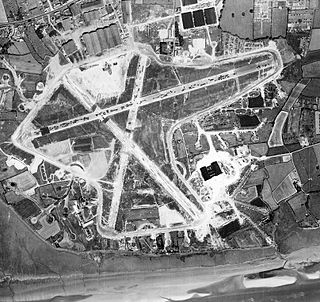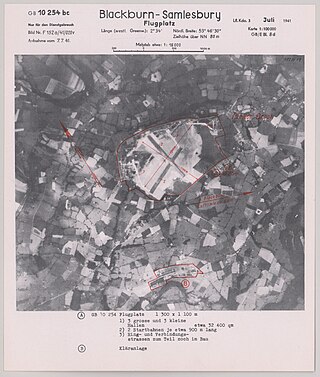
Blackburn Aircraft Limited was a British aircraft manufacturer from 1914 to 1963 that concentrated mainly on naval and maritime aircraft.

The BAE Systems Hawk is a British single-engine, jet-powered advanced trainer aircraft. It was first known as the Hawker Siddeley Hawk, and subsequently produced by its successor companies, British Aerospace and BAE Systems. It has been used in a training capacity and as a low-cost combat aircraft.

Royal Air Force Leeming or more simply RAF Leeming is a Royal Air Force station located near Leeming, North Yorkshire, England. It was opened in 1940 and was jointly used by the RAF and the Royal Canadian Air Force (RCAF). Between 1950 and 1991, it operated mostly as a training base with Quick Reaction Force (QRF) Panavia Tornado F3 fighters based there in the latter stages of the Cold War and into the early 21st century. Since 2006, it has become the home of the deployable RAF communications cadre and the home of No. 135 Expeditionary Air Wing.

Royal Air Force Valley or more simply RAF Valley is a Royal Air Force station on the island of Anglesey, Wales, and which is also used as Anglesey Airport. It provides both basic and advanced fast-jet training using the Beechcraft Texan T.1 and BAE Systems Hawk T.2 and provides mountain and maritime training for aircrew using the Airbus Jupiter HT.1 helicopter.

Royal Air Force Mona, or more simply RAF Mona, is a Royal Air Force station near Bodffordd on the island of Anglesey, Wales. It is primarily used as a relief landing ground for RAF Valley.

Filton Airport or Filton Aerodrome was a private airport in Filton and Patchway, within South Gloucestershire, 4 NM north of Bristol, England.

Brough is a town in the East Riding of Yorkshire, England. It is part of the civil parish of Elloughton-cum-Brough with the neighbouring village of Elloughton. Brough is situated on the northern bank of the Humber Estuary, approximately 12 miles (19 km) west of Hull city centre. Brough has a long association with BAE Systems.

No 208 (Reserve) Squadron was a reserve unit of the Royal Air Force, most recently based at RAF Valley, Anglesey, Wales. It operated the BAe Hawk aircraft, as a part of No. 4 Flying Training School. Due to obsolescence of its Hawk T.1 aircraft compared to the new-build Hawk T.2 aircraft of its sister unit, 4(R) Sqn, the squadron was disbanded in April 2016, in its 100th year of operations.

Ipswich Airport was an airfield on the outskirts of Ipswich, Suffolk England. It was known as RAF Nacton when No. 3619 Fighter Control Unit of the Royal Auxiliary Air Force were based there.

Warton Aerodrome is an airfield located in Warton village on the Fylde in Lancashire, England. It is 7 miles (11 km) west of Preston, Lancashire. The western end of the site adjoins the village of Freckleton.
BAE Systems Military Air & Information is a business unit of British defence company BAE Systems responsible for the design, development, manufacture and support of fixed wing military aircraft. MAI customers include the Royal Air Force, Royal Saudi Air Force, US Navy and Indian Air Force.

The aerospace industry of the United Kingdom is the second-largest national aerospace industry in the world and the largest in Europe by turnover, with a global market share of 17% in 2019. In 2020, the industry employed 116,000 people.
Hatfield Aerodrome was a private airfield and aircraft factory located in the English town of Hatfield in Hertfordshire from 1930 until its closure and redevelopment in the 1990s.

Samlesbury Aerodrome is a disused airfield at Balderstone near Samlesbury and Blackburn in the Ribble Valley district of Lancashire. The aerodrome is owned by defence company BAE Systems which uses the site for the manufacture of several different aircraft. Currently the company employs approximately 3,000 people at the site. The aerodrome is part of Lancashire Enterprise Zone.

736 Naval Air Squadron was a Naval Air Squadron of the Royal Navy's Fleet Air Arm. It was most recently recommissioned at HMS Seahawk, RNAS Culdrose in June 2013 to fly the BAE Systems Hawk, mainly in the maritime aggressor role, following the disbandment of the Fleet Requirements and Aircraft Direction Unit (FRADU) and operated up until March 2022. It initially formed as the School of Air Combat in May 1943 at HMS Heron, RNAS Yeovilton. In September 1943 it moved to HMS Vulture, RNAS St Merryn, where it became the Fighter Combat School and it created an independent 'B' Flight for fighter affiliation work between March and September 1945. 736 Naval Air Squadron moved to HMS Seahawk, RNAS Culdrose in February 1950 as the Naval Air Fighter School in the 52nd Training Air Group, but disbanded in August 1952. Immediately the following day, the squadron reformed at HMS Seahawk, RNAS Culdrose out of 702 Naval Air Squadron as an Advanced Jet Flying School and in November 1953 it moved to HMS Fulmar, RNAS Lossiemouth. 736 Naval Air Squadron disbanded there in March 1965, but what was left became 764 Naval Air Squadron ‘B’ Flight. The squadron reformed the same day at Lossiemouth from 809 Naval Air Squadron as a Jet Strike Training Squadron. 1966. In March 1967, its aircraft were part of the group that bombed and set on fire the supertanker SS Torrey Canyon aground and leaking crude oil on Seven Sisters rocks off Cornwall. The squadron disbanded in February 1972.

Dunsfold Aerodrome is an unlicensed airfield in Surrey, England, near the village of Cranleigh. It extends across land in the villages of Dunsfold and Alfold.
Captain Norman William George Blackburn, was a British pilot and flying instructor during the First World War, and afterwards a director of Blackburn Aircraft.

RAF Holme-on-Spalding Moor, or more simply RAF Holme is a former Royal Air Force station located in the East Riding of Yorkshire, England.

The UK Military Flying Training System (UKMFTS) takes UK armed forces aircrew from initial training through elementary, basic, and advanced flying training phases, preparing them for their arrival at their designated operational aircraft units. It is operated by Ascent Flight Training, a consortium of Lockheed Martin and Babcock International under a 25-year Private Finance Initiative (PFI) contract for the UK's Ministry of Defence (MoD), with oversight from the MoD. The airworthiness authority for each aircraft type, for example, is fulfilled by military and civilian staff within Defence Equipment and Support. Apart from the overall contract, the main elements of the system include fixed-wing elementary, multi-engine and fast-jet pilot training, rear crew training and rotary-wing (helicopter) training.
Royal Air Force Bellasize, also known as RAF Bellasize, was a former RAF airfield in the hamlet of Bellasize, near Gilberdyke, East Riding of Yorkshire, England. Originally opened in 1916, Bellasize was one of only four Yorkshire-based RAF locations to see use in the First and Second World Wars. Flying at Bellasize was sporadic and training based, with the site not being used in an offensive capacity during the Second World War.

















